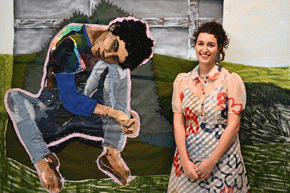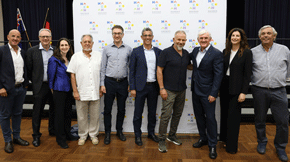Mahler’s longest – but worth the wait: a music review by Fraser Beath McEwing
The perceived popularity of Mahler’s third symphony was illustrated by the SSO scheduling four performances, three of them in its APT Master Series – rare for any work. The first, in the Opera House last night, vindicated the decision, with a virtually full house which was rewarded with an outstanding musical event.

David Robertson and members of the SSO Photo: Ken Butti
Running for more than an hour and a half, Mahler’s third is the longest of his 10, and one of the longest single works in the symphonic orchestral repertoire. Not only that, but Gustav’s instrumental menu calls for stage-filling numbers plus a mezzo-soprano and a couple of choirs for good measure. The SSO bull fiddle count was eight, along with eight horns, two dueling harps, two timpani players who appeared trying to out-wallop each other, lashings of strings, four flutes, five clarinets, four trombones and the usual solitary but powerful tuba. In addition, there was a prominent part for an 18th century instrument called a post-horn, used to signal the arrival and departure of mail coaches – when letters arrived quicker than they do today. In this performance, it was replaced by a flugelhorn, whose creamy sound came from offstage in extended, plaintive concerto-like passages.
Mahler’s third is a kaleidoscope of quotations from other composers and other works by Mahler himself. As if to balance this amalgam, it has been pulled apart and used for several other purposes, including film music. This is why, perhaps, first time listeners may think they’ve heard it before. They probably have. Moreover, it has been rearranged in a ‘lite’ version where only a platoon of musicians is required to play it rather than a whole regiment that had to be assembled for last night’s performance. So, at a stretch, you might say that the third imitates the cosmos in its coming together and flying apart.
Mahler is quoted as saying “a symphony must be like the world; it must embrace everything.” That is probably one of the reasons why his symphonies turn musicians and audiences into travelling companions. The journey is usually long and everybody has a sense of mutual destination. Mahler’s Symphony No.3 in D minor has precisely this effect.
There are six movements (after revisions which saw the seventh dropped), each with a program note from Mahler – who is quick to request that we don’t go looking for too much literal meaning – as one might in Beethoven’s Pastoral symphony. The movements, in order, are titled: summer marches in; what the meadow flowers tell me; what the creatures of the forest tell me; what night tells me; what the morning bells tell me; what love tells me.
At this stage, the women from the Sydney Philharmonic choirs (musical director Brett Weymark) had assembled to sit demurely in the choir stalls awaiting the stand-up signal, but the kids from the Sydney Children’s Choir were still outside – maybe enjoying a paddle pop.

Fraser Beath McEwing
The first movement, (also called part one) is the longest and begins with a huge announcement from brass and percussion. Here, Mahler has done a spot of borrowing. He takes the main theme from the fourth movement of Brahms first symphony, reshapes it a minor key, and lets it rip. The theme reappears in various guises throughout the movement until it reasserts itself towards the end. Some performances give a breather at this point because the audience has been confined for 35 minutes, but not on this occasion – although the audience couldn’t help applauding after the climatic finish. Conductor David Robertson smiled broadly and dipped sideways for a bowette. He doesn’t mind mid-work applause, but being on the stuffy side, I’m not fond of it.
Part two, which takes in the next five movements, saw the children’s choir (artistic director, Lyn Williams) file in to applause, and the arrival of mezzo-soprano Susan Graham who looked splendid in a pink and navy lace long gown. Her voice was splendid too as it rose richly above the orchestra and fulfilled the special demands of singing Mahler on stage.
The simply expressed second movement provided some respite from the swirling passion and blasts of the first, and prepared the ground for movement three with the flugelhorn solo, then on to four and five which brought human voices into play. Both choirs responded perfectly to Robertson’s directions and sang without the benefit of scores.
If Mahler is going to make you cry, it will happen in the sixth and final movement. As David Larkin said in his pre-concert talk, we were in for a blissful 20 minutes, beginning with a barely-there adagio and building into and out of emotional waves that, in the wrong hands, could be taken as schmaltz. And just when you might expect that the movement will slowly sink into a misty silence it makes a final grand statement underpinned by the two timpanists hammering their skins in explosive unison.
SSO Opera House concert 19 July 2017
Fraser Beath McEwing is an accomplished pianist and commentator on classical music performance and is a founding member of The theme & Variations Foundation Advisory Board which provides assistance to talented young Australian pianists. His professional background is in journalism, editing and publishing. He is also the author of three novels. and a Governor of the Sir Moses Montefiore Home.








